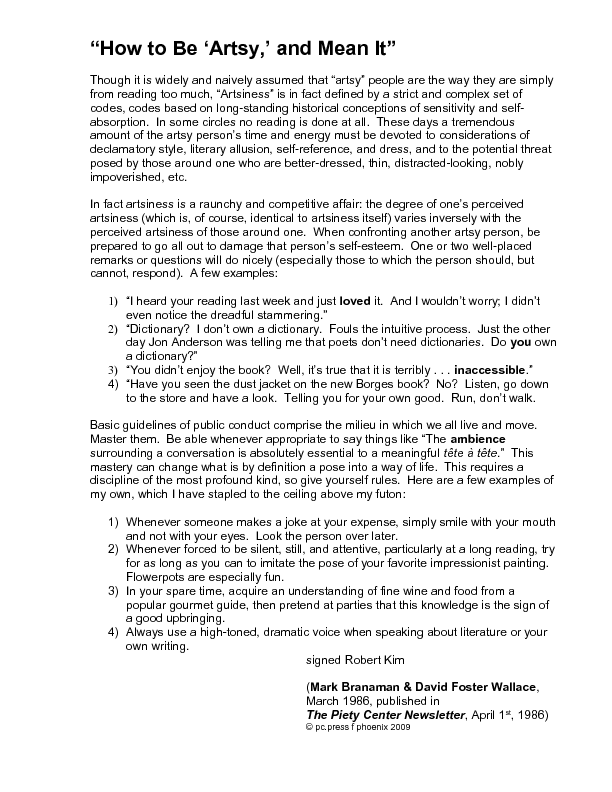Remembering DFW 2010(I'll keep updating as interesting things pop up) Ryan Blanck 9/12 DFW Event on Austin Radio KOOP (97.1 FM) featuring Matt Bucher Shane Richmond (Which of course assumes there’s a point) Mr. Smarty Pants David Foster Wallace Add new comment
Remembering David Foster WallaceI still struggle on this day. But today has been filled with joy too. Watching my three year old son play with his (slightly) older cousins reminds me of the unusual and powerful bonds one sometimes forms with relatives that you don't see all that often. As a result I'm left thinking about the strange, and comfortable, and exciting, and reassuring, and altogether rewarding experience of meeting other David Foster Wallace scholars and enthusiasts in New York last year. That was the greatest distance I've travelled to meet with people who are not my family, and yet, many of the people I met felt most certainly like they could have been. You all know who you are. David Foster Wallace's work seems to do that. It brings people together. It makes us consider others. It make us care. So on this day I like to take some time out to and think about the impact his work has had on my life. And here's the thing, it's more like I've allowed his work have an impact on my life. There's a conscious and personal choice going on here - and that's a very good thing. So today, remember David Foster Wallace... ...and maybe take the time to read a few of the pieces below. They are some of my fave pieces by and about him. Nick Maniatis
Interested in excellent critical essays about David Foster Wallace? Consider David Foster Wallace: Critical Essay
All Things ShiningI've heard on the grape vine (okay, so I'm reposting from wallace-l) that 'Sean Kelly, a philosopher at Harvard, has a book coming out, "All Things Shining: Reading the Western Classics to Find Meaning in a Secular Age," which will have a long chapter on DFW.' Check out Sean's blog, All Things Shining for some DFW related posts: The cruise ship and the open ocean
(via Jordan and wallace-l) DFW's Universal Inner ChildMatt Feeney has posted an essay about Infinite Jest over at The American Scene, Infinite Manic Sadness: DFW's Universal Inner Child: Either way, for Wallace, the formal extremity underwrites (aesthetically, I would say) a set of extremes of melodrama and pathos. Infinite Jest is a hilarious comedy, but it is also a sad, sad book of bitter pain and textbook addiction and abuse, and it is an old-fashioned romance...
See also Ned Resnikoff's David Foster Wallace and Nietzschean Nihilism Calling Reader Questions for David LipskyUpdate: I've received a couple of questions via email and there are a couple in the comments. So I'll give you all one more week to submit yor questions. I'm now assuming that all of you who wanted to read David Lipsky's road-trip/biography of David Foster Wallace, Although of Course You End Up Becoming Yourself, have done so. It's time for the next part of the journey. When David Lipsky and I were working on the Howling Fantods Q&A we agreed to allow Howling Fantods readers to ask some questions too. I thought it would be more interesting to take questions after everyone had read the book. So here we are. Let's try to cover new ground, so make sure you read the Howling Fantods Q&A , The American Fiction Notes Q&A , and the wallace-l Interview before you propose your question. I'll put the best 10 or so questions to David Lipsky and we'll see how it goes. Post your question in the comments section below (or via the contact us link). I'll close comments in about a week and give a warning with a couple of days to go.
How to Be Artsy, and Mean ItI think this speaks for itself. “How to Be ‘Artsy,’ and Mean It” by Mark Branaman and David Foster Wallace, March 1986. Published in The Piety Center Newsletter [cover pic], April 1st, 1986. [Thanks, jt]  |
|
|
|
|
More Articles...
|
|
|
|



